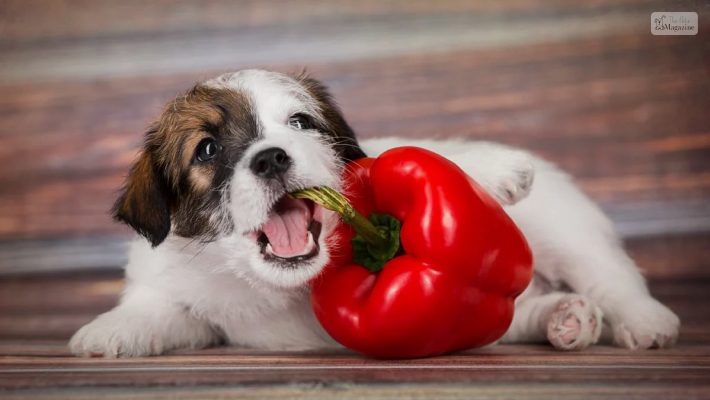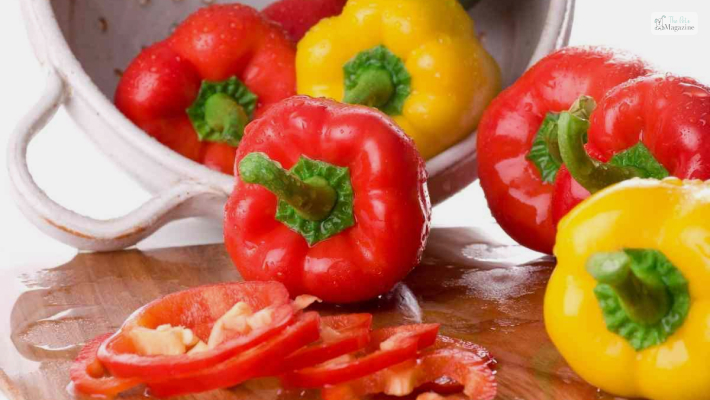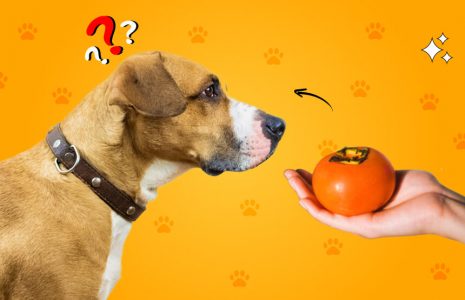“Can My Dog Eat Bell Peppers? Exploring the Safety and Health Benefits”


Generally, dog parents love to share their food with their fur babies. So a person who loves pepper would want to share their food as well with their dogs. Bell peppers can be very healthy for humans, but are they healthy for our dogs? Can dogs eat bell peppers? Yes, they are. It is safe for dogs to have bell peppers; they are rich in nutrients.
This is a very healthy snack for humans. They are crunchy and colorful. But as a matter of fact, they are non-toxic for dogs as well. But make sure you give them bell peppers and not hot peppers. They can cause discomfort in your pets. Spicy peppers are not toxic to dogs, but they cause irritation in them like vomiting, bowel problem, and diarrhea.
What kind of peppers can be given to them?
Bell peppers, generally, are not toxic to dogs, but red bell peppers are the ones that are recommended for dogs. Red bell peppers are rich in vitamin C, vitamin A, and vitamin E. They also have lots of antioxidants. So, if you are worried an thinking, can dogs eat bell peppers, then you can give them red bell peppers with your eyes closed.

Compared to any other bell peppers, red bell peppers have the richest amount of vitamins and minerals, and other nutrients. it improves their immune system. It acts as an anti-inflammatory which benefits dogs with arthritis. It is good for all older dogs as well. Red bell peppers are rich in beta-carotene and have nine times more than green and yellow peppers.
Beta-carotene converts itself inside the body to vitamin A. This is a very good characteristic of bets-carotene. This is a natural way to keep your dog healthy from both outside and inside.
Which Types of Peppers Are Not Safe For Dogs?
It’s crucial to avoid any spicy peppers like jalapeños, chili peppers, and habaneros, as they contain a compound called capsaicin and piperine. It can be irritating to a dog’s digestive system and can cause inflammation and a burning sensation in the mouth and stomach. Eating a large quantity of spicy peppers can cause extreme discomfort and lead to a lot of serious health issues. If you suspect that your dog has consumed pepper, then here are some signs and symptoms you need to watch out for:
- Gastrointestinal distress such as Vomiting, Diarrhea, Abdominal pain and Excessive drooling
- Dizziness or falling down
- Hallucinations
- Smacking lips
- Pawing at mouth
- High body temperature
- Dilated pupils
- Jaundice (yellowing of eyes and skin)
- Paralysis
- Inability to rise from lying down
- Altered heart rate
- Rapid heartbeat
- Muscle contractions and cramps (usually in the abdominal area)
- Gastrointestinal ulcers
- Seizures
What are the nutritional qualities of bell peppers?
Bell peppers are good for dogs as they are low in calories and are packed with nutrients. Let’s see what the nutrients bell pepper has.

- Vitamin A: Helps in growth, keeps the vision healthy, and makes the immune system strong.
- Vitamin B6: Produces red blood cells and helps in the proper healthy functioning of the brain.
- Vitamin C: Lessens any signs of aging and reduces inflammation.
- Vitamin E: Helps in growing strong, healthy muscles and keeps them healthy.
- Vitamin K: Keeps the eyes and bones healthy and strong.
- Beta-carotene: Keeps their coat and skin healthy as well as helps in keeping the eyes healthy.
How to feed them bell peppers properly?
Just as we humans try some random cuisine of food suddenly, it is not easy for our pups to d the same. It is better to introduce the food to them slowly.

- Clean the peppers properly before giving them the bell peppers. Then cut out the seeds and stem of the peppers.
- It is difficult for many dogs to digest raw peppers; if that is the case, then just steam or boil it before giving it to them. Do not add any seasonings or add garlic and onion powder to it. Garlic and onion are toxic for dogs, and salt can cause dehydration in them.
- Generally, dogs like the crunchiness of the bell peppers and the sweetness of it, but they still need to be introduced to them slowly to see how they react to it.
- Large dogs should eat less than half a pepper, and small dogs less than a quarter of a pepper at a time to prevent indigestion.
- If you are giving them as treats, then cut them into small pieces so that they do not choke on them. Also, treats should be 10% of their total daily calorie intake.
How Can I incorporate Bell Peppers into my dog’s diet?
Incorporating bell peppers into your dog’s diet can be both nutritious and enjoyable for your furry friend. Here are some safe and creative ways to do so:
As a Meal Topper:
Chop raw or cooked bell peppers into small pieces and sprinkle them over your dog’s regular food at mealtimes. The veggies will add flavor, texture, nutrients, and appeal to their bowl.
Training Treats:
Dice bell peppers into small, bite-sized pieces and use them as rewards during training sessions to reinforce positive behavior.
Freeze for a Cool Treat:
Slice bell peppers into strips or chunks. Then, freeze them for a refreshing and crunchy snack on hot days.
Stuffed into Toys:
Stuff bell pepper pieces into food-dispensing and interactive toys for dogs like kongs. This provides mental stimulation and enrichment for your dog, especially when they are left alone at home.
What are the other vegetables that dogs cannot eat?
Besides pepper, there are several other vegetables that are not safe for dogs. These include:
- Chives: This vegetable can damage a dog’s red blood cells when ingested, so It’s best to keep chives away from your furry friend.
- Kale: While kale is nutritious for humans, it contains calcium oxalate, which can harm a dog’s kidneys. Be cautious with kale, especially the florets, as they contain isothiocyanate, a potentially harmful compound.
- Leeks: It can cause red blood cells to rupture in dogs. So, avoid feeding leeks to your canine companion.
- Mushrooms (except certain store-bought varieties): Wild mushrooms can be extremely poisonous, and even some cultivated mushrooms can be harmful to dogs. If you’re unsure about a mushroom, it’s best to err on the side of caution and avoid letting your dog eat it.
- Tomatoes: Avoid feeding your dog young, green tomatoes as they belong to the nightshade family of vegetables. This means that the plant possesses toxic compounds called solanine and tomatine, which can cause muscle weakness, tremors, and seizures.
Frequently asked questions
Yes, eating raw bell peppers is absolutely okay for dogs. It is better to remove the seeds and stem of the bell peppers so that they do not choke on them. It can also damage their teeth.
But remember, it should be bell peppers and not any other kind of spicy peppers. That can cause severe discomfort in them.
This is the only kind of pepper that dogs can have because they do not contain capsaicin, the compound which provides heat to the other kinds of peppers.
It is not that capsaicin is a dog toxin, but it can be the reason for causing gastrointestinal discomfort and uneasiness in dogs.
Yes, absolutely, they can. As mentioned above, this is the best kind of bell peppers for dogs as these are very rich in nutrients and help in keeping the dog healthy.
Yes, they can eat yellow bell peppers. As long as it is bell peppers, it is okay to give your pup.
Yes, green peppers are okay for your dogs as long as it is bell pepper. Other kinds are not recommended, like serrano or jalapenos. They are too spicy for your dog. Bell peppers change colors as they ripen.
They start from green, then turn to yellow, then turns orange, and lastly, red. The green kins are the least sweet, and the red bell peppers are the sweetest.
Yes, it is okay to give them cooked bell peppers but make sure you don’t put any kind of seasoning or oil in them. If your dog has a history of digestion issues or if they do not adapt well to new treats, then just cook it lightly or steam them before giving it to your dog.
Cooking bell peppers will break down the fiber, and it will be easy for them to digest. Do not give them the same food you are eating. They won’t handle the spices and seasoning well.
Conclusion
Bell peppers are good for pups in general, so there is a very simple answer to the question, “can dogs eat bell peppers?” the answer is yes, but if you notice any kind of adverse reaction in them, contact your vet immediately.
Dogs don’t enjoy all human foods, so if you want an exact diet that would help your pup, then it is best to consult a vet. Remember, never give them any kind of spicy peppers.








Leave A Comment